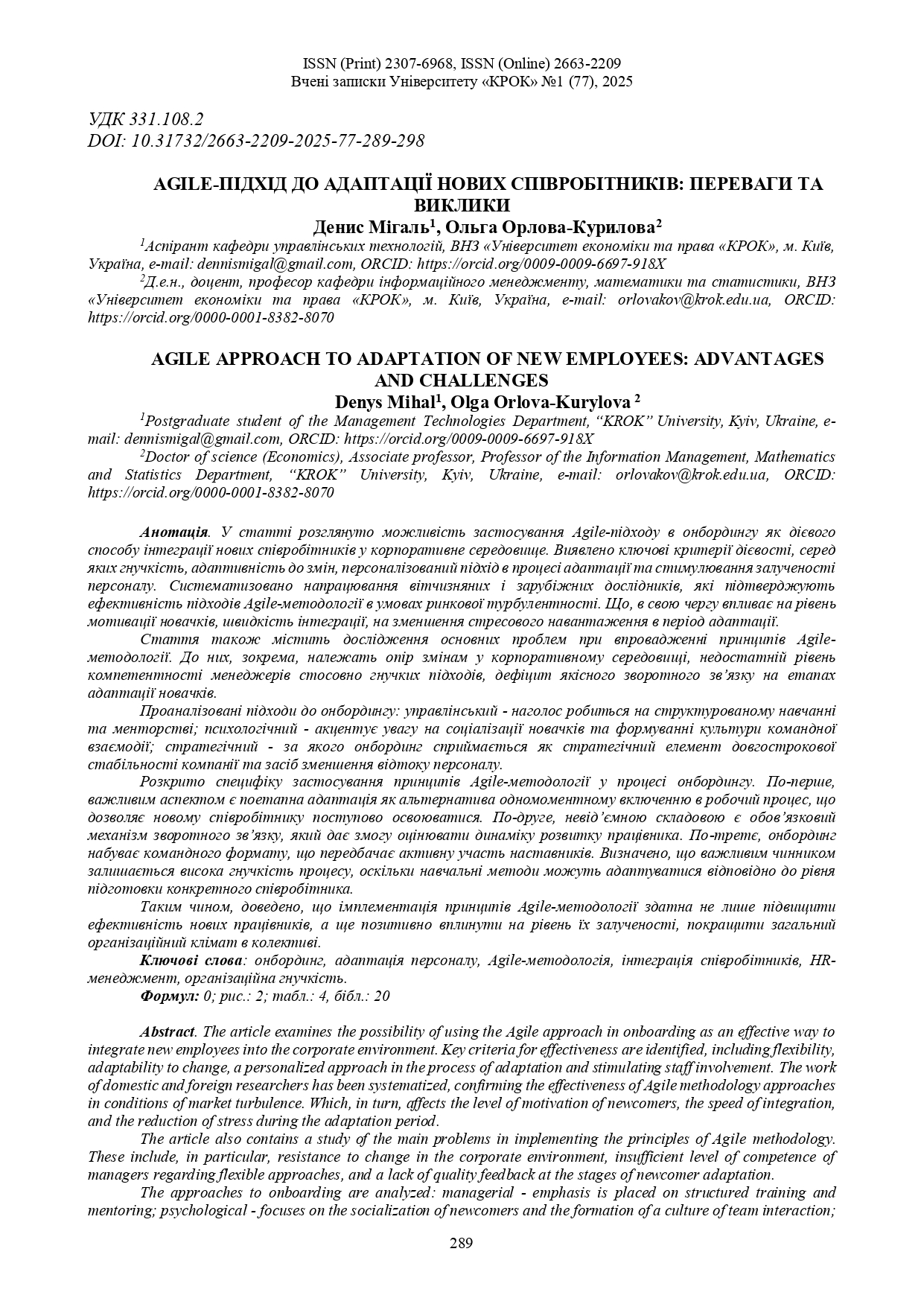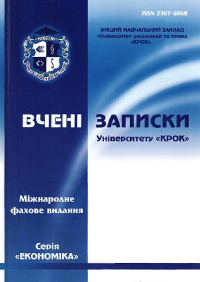AGILE-ПІДХІД ДО АДАПТАЦІЇ НОВИХ СПІВРОБІТНИКІВ: ПЕРЕВАГИ ТА ВИКЛИКИ
DOI:
https://doi.org/10.31732/2663-2209-2025-77-289-298Ключові слова:
онбординг, адаптація персоналу, Agile-методологія, інтеграція співробітників, HR-менеджмент, організаційна гнучкістьАнотація
У статті розглянуто можливість застосування Agile-підходу в онбордингу як дієвого способу інтеграції нових співробітників у корпоративне середовище. Виявлено ключові критерії дієвості, серед яких гнучкість, адаптивність до змін, персоналізований підхід в процесі адаптації та стимулювання залученості персоналу. Систематизовано напрацювання вітчизняних і зарубіжних дослідників, які підтверджують ефективність підходів Agile-методології в умовах ринкової турбулентності. Що, в свою чергу впливає на рівень мотивації новачків, швидкість інтеграції, на зменшення стресового навантаження в період адаптації.
Стаття також містить дослідження основних проблем при впровадженні принципів Agile-методології. До них, зокрема, належать опір змінам у корпоративному середовищі, недостатній рівень компетентності менеджерів стосовно гнучких підходів, дефіцит якісного зворотного зв’язку на етапах адаптації новачків.
Проаналізовані підходи до онбордингу: управлінський - наголос робиться на структурованому навчанні та менторстві; психологічний - акцентує увагу на соціалізації новачків та формуванні культури командної взаємодії; стратегічний - за якого онбординг сприймається як стратегічний елемент довгострокової стабільності компанії та засіб зменшення відтоку персоналу.
Розкрито специфіку застосування принципів Agile-методології у процесі онбордингу. По-перше, важливим аспектом є поетапна адаптація як альтернатива одномоментному включенню в робочий процес, що дозволяє новому співробітнику поступово освоюватися. По-друге, невід’ємною складовою є обов’язковий механізм зворотного зв’язку, який дає змогу оцінювати динаміку розвитку працівника. По-третє, онбординг набуває командного формату, що передбачає активну участь наставників. Визначено, що важливим чинником залишається висока гнучкість процесу, оскільки навчальні методи можуть адаптуватися відповідно до рівня підготовки конкретного співробітника.
Таким чином, доведено, що імплементація принципів Agile-методології здатна не лише підвищити ефективність нових працівників, а ще позитивно вплинути на рівень їх залученості, покращити загальний організаційний клімат в колективі.
Завантаження
Посилання
Бойко, А., & Ситник, Й. (2024). Напрями вдосконалення процесу адаптації персоналу ІТ-підприємств. Економіка та суспільство, (63). https://doi.org/10.32782/2524-0072/2024-63-122
Борщов, В., & Орлова-Курилова, О. (2024). AGILE-менеджмент у складних умовах: виклики та стратегії при дистанційній роботі під час війни в Україні. У Сучасний менеджмент організації: витоки, реалії та перспективи розвитку. https://conf.krok.edu.ua/MMO/MMO-2024/paper/view/2126
Буряк, М., & Маковоз, О. (2023). Методологія гнучкого управління змінами як інструмент організаційної трансформації. Київський економічний науковий журнал, (3), 18-23. https://doi.org/10.32782/2786-765X/2023-3-3
Данченко, О., Борисов, О., & Гайдаєнко, О. (2023). Застосування онбордингу в управлінні командами продуктових ІТ-проєктів. Управління розвитком складних систем, 29-37. http://mdcs.knuba.edu.ua/article/view/291120/284696
Кравчук, О. І., Варіс, І. О., & Яковленко, М. В. (2024). Теоретико-методичні засади та сучасні практики онбордингу персоналу в системі кадрового забезпечення підприємства: виклики та адаптація в умовах війни. Економіка та суспільство, (66), 67–73. https://economyandsociety.in.ua/index.php/journal/article/download/4536/4479/
Лошенюк, О. (2022). Автоматизація управління бізнес-процесами підприємства як основа гнучкості його діяльності: характеристика систем управління. Економіка та суспільство, (45). https://doi.org/10.32782/2524-0072/2022-45-46
Мігаль, Д., & Орлова-Курилова, О. (2024). Порівняльний аналіз принципів Agile-методології та принципів управління Анрі Файоля: сучасний погляд на управління персоналом. У Держава, регіони, підприємництво: інформаційні, суспільно-правові, соціально-економічні аспекти розвитку. Отримано від https://conf.krok.edu.ua/SRE/SRE-2024/paper/view/2579
Мішеніна, Г. А., & Павленко, Д. С. (2020). Особливості та перспективи застосування Agile в діяльності органів публічної влади в умовах трансформаційних перетворень системи державного управління України. Вісник Сумського державного університету. Серія Економіка, (4), 139−151. https://doi.org/10.21272/1817-9215.2020.4-16
Орлова-Курилова, О. В. (2016). Теоретико-методичні аспекти управління персоналом інноваційного підприємства. Науковий вісник Херсонського державного університету. Сер.: Економічні науки, (19 (2)), 86-91.
Пенюк, В. О. (2024). Адаптація як складова процесу онбордингу персоналу. Бізнес Інформ, (4), 332–338. https://doi.org/10.32983/2222-4459-2024-4-332-338
Супруненко, С., Плотніченко, С., & Агеєва, І. (2024). Адаптація методів Agile-управління в державному секторі України. Публічне управління та адміністрування в Україні, (2), 25-30. https://futurity-publishing.com/wp-content/uploads/2024/06/PROCEEDINGS-BOOK-2.pdf#page=97
Bauer, T. N. (2010). Onboarding new employees: Maximizing success. SHRM Foundation. https://penedulearning.com/wp-content/uploads/2019/05/Onboarding-New-Employees_Maximizing-Success.pdf
Cable, D. M., Gino, F., & Staats, B. R. (2013). Reinventing employee onboarding. MIT Sloan Management Review, 54(3), 23–28. https://enboarder.com/wp-content/uploads/2017/07/Reinventing-Employee-Onboarding.pdf
Carpenter, M. L. (2023). Effective onboarding strategies to increase talent retention. Walden Dissertations and Doctoral Studies, 12085. https://scholarworks.waldenu.edu/dissertations/12085
Ellis, A. M., Nifadkar, S. S., Bauer, T. N., & Erdogan, B. (2017). Newcomer adjustment: Examining the role of managers' perception of newcomer proactive behavior during organizational socialization. Journal of Applied Psychology, 102(6), 993-1001. https://www.researchgate.net/profile/Berrin-Erdogan/publication/320786369_Examining_Managers'_Perception_of_Newcomer_Proactive_Behavior_during_Organizational_Socialization/links/5b5b029d458515c4b24ab9c8/Examining-Managers-Perception-of-Newcomer-Proactive-Behavior-during-Organizational-Socialization.pdf
Frögéli, E., Jenner, B., & Gustavsson, P. (2023). Effectiveness of formal onboarding for facilitating organizational socialization: A systematic review. PloS one, 18(2), e0281823. https://doi.org/10.1371/journal.pone.0281823
Gregory, P., Strode, D. E., AlQaisi, R., Sharp, H., & Barroca, L. (2020). Onboarding: How newcomers integrate into an Agile project team. Agile Processes in Software Engineering and Extreme Programming: 21st International Conference on Agile Software Development, XP 2020, Copenhagen, Denmark, June 8–12, 2020, Proceedings, 383, 20–36. https://doi.org/10.1007/978-3-030-49392-9_2
Klein, H. J., & Polin, B. (2012). Are organizations on board with best practices onboarding? In C. R. Wanberg (Ed.), The Oxford handbook of organizational socialization (pp. 267-287). Oxford University Press. https://books.google.com.ua/books?hl=uk&lr=&id=T1empBxTFwYC&oi=fnd&pg=PA267&ots=YQWkOPj6mZ&sig=FBL0ZOlrVC106gSeNjLcwUBuMuQ&redir_esc=y#v=onepage&q&f=false
Kuhrmann, M., Tell, P., Hebig, R., Klünder, J., Münch, J., Linssen, O., Pfahl, D., Felderer, M., Prause, C., Macdonell, S., Nakatumba-Nabende, J., Raffo, D., Beecham, S., Tüzün, E., López, G., Paez, N., Fontdevila, D., Licorish, S., Küpper, S., & Richardson, I. (2021). What makes Agile software development Agile. IEEE Transactions on Software Engineering, PP. 1-1. https://doi.org/10.1109/TSE.2021.3099532
Saks, A. M., & Gruman, J. A. (2011). Organizational socialization and positive organizational behaviour: Implications for theory, research, and practice. Canadian Journal of Administrative Sciences, 28(1), 14-26. https://onlinelibrary.wiley.com/doi/abs/10.1002/cjas.169

Downloads
Опубліковано
Як цитувати
Номер
Розділ
Ліцензія

Ця робота ліцензується відповідно до Creative Commons Attribution-NonCommercial 4.0 International License.

